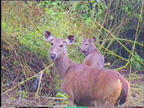|
|
|
Corbett National Park
|
 Located in the Patlidun Valley at the base of the Himalayas in the state of Uttar
Pradesh, Corbett was established in 1936, as the Hailey National Park. India's first
national park and the first sanctuary to come under Project Tiger, Corbett supports
a variety of vegetation making it the ideal habitat for the Tiger and its prey.
Located in the Patlidun Valley at the base of the Himalayas in the state of Uttar
Pradesh, Corbett was established in 1936, as the Hailey National Park. India's first
national park and the first sanctuary to come under Project Tiger, Corbett supports
a variety of vegetation making it the ideal habitat for the Tiger and its prey.
Once a popular hunting ground of the British, this 201 square mile park was named
in honor of the late Jim Corbett, the legendary hunter-naturalist turned author
and photographer who helped in demarcating the park's boundaries. With the help
of the World Wildlife Fund, Project Tiger was launched in Corbett National Park
in 1973 and this park was one of the first such tiger reserves in the country.
The varied topography comprises hilly and riverine areas, temporary marshy depressions,
plateaus and ravines. The lower areas are almost completely populated by sal trees.
In the park are found 110 tree species, 50 mammals species, 580 bird species and
25 reptile species.
Corbett is a haven for tigers with its plentiful prey - four kinds of deer, wild
boar and lesser animals. Leopards are found in the hilly areas of the park but often
do not cross paths with tigers in their territories. Some nocturnal cats found here
are the leopard cat, jungle cat and fishing cat. Sloth bear is found in the lower
regions of the park while the Himalayan black bear is seen in the higher hills only.
The dole (wild dog), though rare, can be seen in the southern areas of the park
along with the jackal. Some of the smaller residents of the park are Himalayan palm
civet, Indian gray mongoose, common otter, blacknaped hare and porcupine. Elephants
(solitary bulls and breeding herds) are one of the main attractions of Corbett.
Along the Ramganga River shores, one can spot the long-snouted, fish-eating gharial
crocodile and the mugger crocodile. Also seen on the rocky hillsides is the ghoral
(goat-antelopes). The langur and rhesus monkeys are well distributed through out
the park and also warn the jungle with alarm calls when they see either a tiger
or leopard from tree-top perches.
Some statistics about the park:
| Animal |
1995 |
1997 |
| Tiger |
90 |
91 |
| Panther |
39 |
40 |
| Elephant |
394 |
602 |
| Sambhar |
3778 |
3816 |
| Chital |
26315 |
26390 |
Area: 520 sqkm
Accommodation: Adjoining the forest reserve - Quality
Inn, Tiger Tops, Forest Rest Houses, Tented Camps and Tourist Huts. The budgeted
traveler can find a host of comfortable rest places in and around the reserve, most
of which are equipped with modern facilities.
How to get there: Road connections from Delhi (290
kms) lead to the Corbett National Park. There are other ways of reaching too. Ramnagar
is the nearest railway station which is about 50 kms from the Park. The nearest
airport is the Delhi Airport.
Best time to visit: Dec - April
For Additional Information:
Field Director, Project Tiger
Corbett National Park
P.O Ramnagar, District: Nainital, Uttar Pradesh
Click here for customized tour
|
|